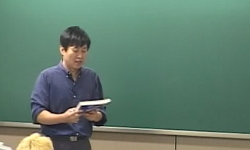Compression and truncation are two general strategies adopted by languages in realizing tonal melodies in the face of time pressure. Compression involves adjustment of the phonetic details of tone realization to fit a tone sequence in the time availab...
http://chineseinput.net/에서 pinyin(병음)방식으로 중국어를 변환할 수 있습니다.
변환된 중국어를 복사하여 사용하시면 됩니다.
- 中文 을 입력하시려면 zhongwen을 입력하시고 space를누르시면됩니다.
- 北京 을 입력하시려면 beijing을 입력하시고 space를 누르시면 됩니다.
https://www.riss.kr/link?id=A100751969
- 저자
- 발행기관
- 학술지명
- 권호사항
-
발행연도
2015
-
작성언어
English
- 주제어
-
등재정보
KCI등재
-
자료형태
학술저널
- 발행기관 URL
-
수록면
359-382(24쪽)
- 제공처
-
0
상세조회 -
0
다운로드
부가정보
다국어 초록 (Multilingual Abstract)
Compression and truncation are two general strategies adopted by languages in realizing tonal melodies in the face of time pressure. Compression involves adjustment of the phonetic details of tone realization to fit a tone sequence in the time available, while truncation involves deletion of a phonological tone, reducing a melody to fit the segmental material with which it must be associated. Seoul Korean appears to show truncation of tones in response to time pressure resulting from fast speech rate: the Accentual Phrase (AP) is canonically marked by a rise-fall-rise melody (LHLH), but at fast speech rates, APs can be realized with a rising F0 contour. Categorical tone deletion conditioned by speech rate would be theoretically significant because it would imply that a phonological operation can be conditioned by utterance-specific phonetic detail. However, analysis of the realization of the AP melody across a range of speech rates provides evidence that the apparent deletion of tones is actually the end result of compressing the final HLH sequence into such a short interval that the low tone is completely undershot and the two high tones are effectively merged. This analysis illustrates the general point that it is not possible to determine what phonological representation gave rise to a particular phonetic form without explicit analysis of the process of phonetic implementation.
목차 (Table of Contents)
- 1. Introduction
- 2. Experiment
- 3. Analysis
- 4. Discussion and conclusion
- REFERENCES
- 1. Introduction
- 2. Experiment
- 3. Analysis
- 4. Discussion and conclusion
- REFERENCES
동일학술지(권/호) 다른 논문
-
The perception of foreign accent in prosody-transplanted speech
- 한국음운론학회
- Joo-Kyeong Lee
- 2015
- KCI등재
-
- 한국음운론학회
- 장혜진(Jang, Hyejin)
- 2015
- KCI등재
-
Corpus-based study of durational adjustment in Korean
- 한국음운론학회
- Tae-Jin Yoon
- 2015
- KCI등재
-
- 한국음운론학회
- Shinsook Lee
- 2015
- KCI등재






 스콜라
스콜라






